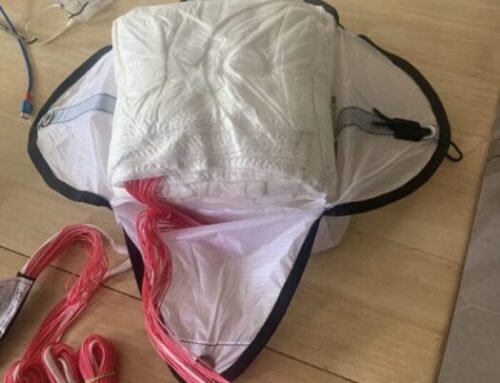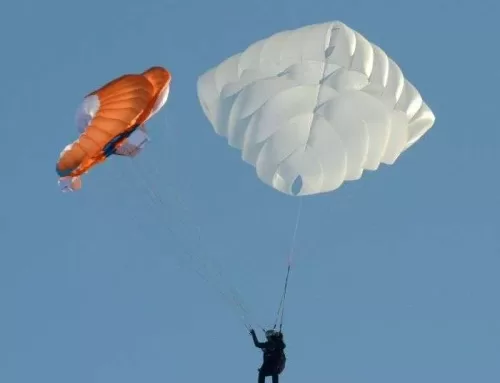Sourcing and Selecting Rubber Bands for Repacking Paragliding Reserves
When it comes to paragliding, safety is of utmost importance and so are rubber bands.
One crucial aspect of maintaining safety is ensuring that the reserve parachute is properly packed and secured. Rubber bands play a vital role in this process, as they are used to secure the reserve parachute in its packed state. In this article, we will discuss the importance of sourcing and selecting the right rubber bands for repacking paragliding reserves.
Understanding the Role of Rubber Bands:
Rubber bands are used to contain the line stows in the container and when deployed, keeping them from tangling. We want the stowed lines of a paragliding reserve to systematically deploy when thrown, containing & releasing the lines as the container moves away from us.
Bands too tight will hinder the release and too loose will allow them to fall away prematurely possibly causing line overs or twists.
Some reserve containers also use rubber bands as part of the closure system using a bight of the lines through a rubber band, others use a small bungee.
We want a rubber band that stays elastic & doesn’t become gummy or brittle before our next repack. The quality and condition of the rubber bands are crucial to ensure the reserve parachute functions properly in case of a reserve toss.
Sourcing High-Quality Rubber Bands:
It is essential to source rubber bands from reputable suppliers who specialize in manufacturing high-quality products. Look for suppliers who have experience in producing rubber bands specifically for paragliding reserves or other similar applications.
Keener Rubber in Ohio was for many years a supplier of rubber bands for skydiving and paragliding. But, as of 2023, calls made to their headquarters indicated they had ceased production.
Alliance Rubber in Hot Springs, Arkansas, USA appears to be the only Company in the US that is manufacturing “Parachute Bands” that once conformed to MIL-STD-105e. Alliance’s bands are manufactured from natural crepe rubber (a latex product). On their website, they have a minimum order of 200 pounds (rubber bands anyone?)
EPDM Rubber Bands are being tested for skydiving applications and may prove to be a suitable band for paragliding also.
Material Quality:
Rubber bands used for paragliding reserves should be made from durable and long-lasting materials. Natural rubber or synthetic rubber compounds with high elasticity and resistance to degradation are preferable.
Compliance with Standards:
Check if the rubber bands you’re using meet any relevant industry standards or certifications. For example, some manufacturers produce rubber bands that comply with specific load-bearing requirements or safety regulations. Choosing rubber bands that adhere to recognized standards adds an extra layer of assurance.
3. Selecting the Right Size Rubber Bands for your paragliding reserve:
Rubber bands come in various sizes and strengths. It is crucial to select rubber bands that are appropriate for the reserve parachute being repacked. The rubber bands should have enough elasticity to securely hold the lines, but not be overly tight. How many bights or figure eights you contain with the rubber band will determine the diameter band you need.
Different reserve parachutes may have specific requirements for the size and arrangement of rubber bands. Consult the manufacturer’s guidelines or seek advice from experienced paragliding professionals to ensure compatibility.
Are silicone rubber bands suitable?
At a recent repack clinic, our instructor who repacks a lot of reserves told us of finding colored hair bands that had fused to the lines. They are now recommending using only natural rubber bands.
Silicone doesn’t melt at the temperatures we should be storing our paragliding gear at. Using a heat gun, I’ve tested a few different bands, marketed as silicone hair bands. Some have become soft & stuck to the cotton towel I laid them on while testing. We suspect there are different qualities of bands sold as hair bands and caution should be used if you decide to use these.
Longevity:
It’s not uncommon to hear of bands that became gummy, brittle or fused to the lines, click on this hyperlink to see one discovered during a repack. Not something you want to discover in the air!
Rubber bands will degrade over time due to exposure to sunlight, fluorescent lighting, and heat. Exposure to electromagnetic current (found near electrical panels, mobile phones and computer screens) can also damage the bands. Performing an inspection on the condition of the rubber bands between repacks is advised.
We should always replace all the bands during each re-pack.
How to measure a rubber band:
Flat Length: measure by laying the band flat and measuring from end to end. This is also half of the circumference.
Cut width: measure across the band perpendicular to the flat length. The distance from one cut edge to the other.
Wall Thickness: measure the narrow edge of the band 90 degrees from the cut width. It’s the distance from the inner to outer surface.
Sizes:
- sizes are numbered from smallest to largest.
- Sizes 8-19 are the smallest cut width of 1/16″.
- Sizes 30-35 are 1/8″ wide.
Diameter of the Band:
To determine the diameter of a band,
IF you know the flat length. Multiply the flat length times 2 then divide by 3.14.
Example, what’s the diameter of a 1 1/2″ flat length band? 1 1/2″ x 2= 3 / 3.14 = 0.95 (diameter)
If you know the diameter you need. Multiply the desired diameter by 3.14 then multiply by 2.
Example, we want a 1″ diameter rubber band. 1″ x 3.14 / 2 = 1.57″ flat length
Storage of rubber bands:
Rubber bands will last longer when refrigerated. Let them warm to room temperature before stretching them.
Conclusion:
Sourcing and selecting the right rubber bands for repacking paragliding reserves can be confusing, there seems to be little fact-based data available. We will continue to add to this article as we learn more about this topic.
Regularly inspecting your reserve and replacing the rubber bands, could be more important than selection of a particular band.



